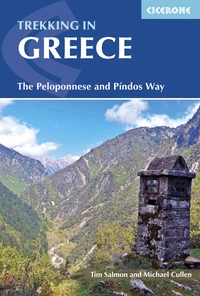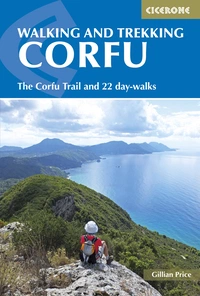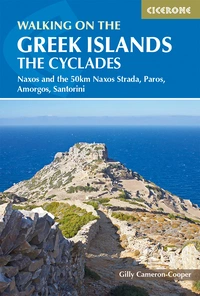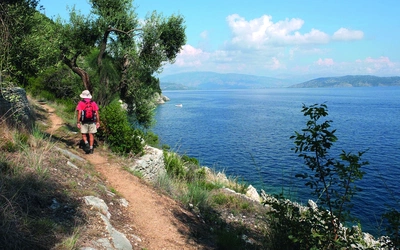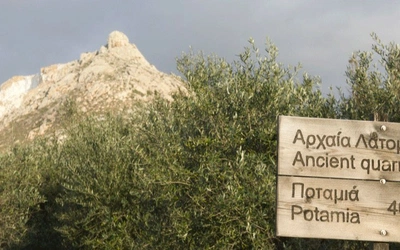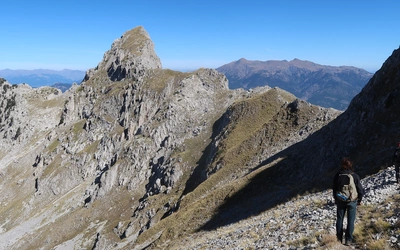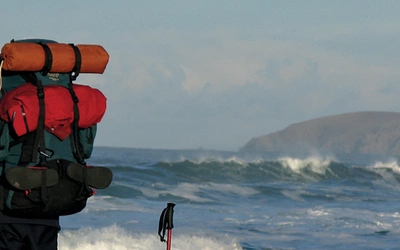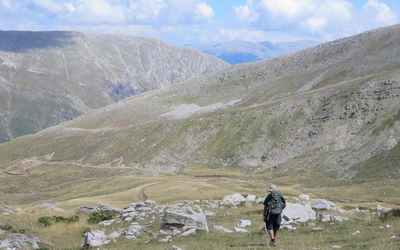Trekking in Greece - the trails and how things have changed
Tim Salmon, who first set foot on Greek soil in 1958 and has been compiling walking guides to the Greek mountains for Cicerone Press with Michael Cullen since the 1970s. Tim recounts his first visit to Greece and how, although the world has moved on in the six decades since, the landscape remains as wonderful as ever.
What is the Peloponnese and Pindos Way?
The Peloponnese and Pindos Way is the name we have given to this route that we have stitched together using the age-old footpaths, running from the north shore of the Peloponnese on the Gulf of Corinth almost to the southernmost tip of the country in the region known as the Máni, and northwards from the little town of Ámfissa, also on the Gulf of Corinth, to the border with Albania in the far north-west.
How difficult are the routes?
Both routes are mountain routes. In the Pindos, you are above 1000m most of the time and above 2000m some of the time. We have divided this part of the route into four sections of about a week. The Peloponnese also climbs to 2000m in places but it does have gentler, low-level passages as well and is generally closer to civilisation and better maintained and waymarked. There are no technical difficulties in either part.
What are the facilities like on the Peloponnese and Pindos Way?
On the Pindos one, some of the sections are reasonably provided with accommodation, but you need to be equipped to camp some of the time. The Peloponnese Way is perhaps not as dramatic as the Pindos, but it has the advantage of board and lodging for every night of the 14 days it takes.
When is the best time to hike in Greece?
Some people are wary of trekking in Greece because of the summer heat. But if you remember that the temperature drops by 7º or 8º with every 1000m of height gain, you can see that it is always a lot cooler in the mountains than by the sea. As for the best times of year: spring of course is magical, with a wealth of wild flowers, a thousand-fold greater than anything we experience in the UK. It is well under way in April in the Peloponnese. In northern parts and at the higher altitudes it comes in June and even July. And there can be snow above 1600-1800m and on north-facing slopes until mid- to late May; not enough to trouble experienced winter hill-walkers but an added difficulty if you are not used to it.
Is there any wildlife?
Wildlife, on the other hand, is comparatively rare. There is a reasonable chance of seeing rock partridge or a deer or catching sight of a lammergeier soaring on its enormous wings. There are a few bears in the north, as well as wild boar and wolves, but you are much more likely to see signs of their presence than ever catch a glimpse of them.
Trekking in Greece
The Peloponnese and Pindos Way
£17.95
Guidebook describing challenging treks in the mountains of Greece, traversing the Pindhos Range, near Athens, and the Peloponnese, plus a handful of shorter routes including Mount Olympus. The treks demand a high level of commitment and fitness due to their remoteness and difficult terrain, and boast stunning unspoilt scenery.
More informationTim recounts the changes in Greece
1950s
I have been in and out of Greece since the late 1950s. There were few roads then and they were mostly dirt. There were few vehicles apart from battered Oldsmobile and Buick taxis, rotovators converted with a trailer for family outings, wartime BMW bikes with two children astride the petrol tank, the wife and a couple more kids riding pillion, and old Dodge buses with proper glass windows, whose rattling could be heard long before they came into sight. Even getting to Greece took three days or so, by a mixture of train and boat. I remember crossing southern Italy in a wooden-seated third class-railway carriage, packed with locals tucking into their picnic lunches. I had nothing.
The boat was a three-funnelled steamer built in Glasgow in 1896. We travelled on deck. It was Easter. At Corfu the boat began to fill up with Greek soldiers going home on leave and peasant families, with their belongings in wicker baskets and bundles of indignant hens parked nose down on the deck. We sailed down the west coast, along the Gulf of Corinth and through the Corinth canal to Piraeus. All the way we could see the distant blue bulwarks of the Pindos range rising behind the coast. There were no roads there. Villages could be two days’ walk from the nearest. High school children walked for 14 hours, sometimes braving snow and ice, to get to their schools for the new term; they had to board, of course.
The advent of tourism in the 1970s
When I returned to Greece in the 1970s, things had begun to change. Many thousands of Greeks, especially from the poor and inaccessible mountain regions, had emigrated to Germany and Australia. Tourism had begun, to my disgust. Even now-famous tourist destinations like Mykonos had been virgin territory in 1960. The ferry dropped anchor in the bay and rowing boats came out to collect the passengers. The terraces where I had been woken in the morning by sheep tripping over my guy ropes had long since disappeared under hotels and apartments.
Where to go now, I thought? Maps – nothing bigger than 1:200,000; the detailed ones were military secrets – showed tracts of roadless brown, all up the Pindos. I had read about an expedition led by Lord Hunt of Everest fame that walked the Pindos from Ámfissa to the Albanian border in 1963. I joined the Athens climbing club and someone told me the wildest region was Ágrafa – the ‘unwritten’ or ‘unrecorded’ places.
I got the bus to Karpenísi, one of the few towns in the mountains. It was a long, slow journey in one of those old Dodges with a gear stick that reached way back behind the driver. The tarmac ended in Karpenísi and I switched to an even older vehicle that pitched and rolled over the dirt track, dropping off passengers and packages at villages and odd bends in the road where there did not seem to be any habitation. Everyone knew everyone.
At Varvariádha we piled out covered in red dust and went into the café, or magazeé as these primitive places are called throughout the mountains. To my surprise, the driver – it was a sort of taxi, it turned out – demanded money from me. When he had gone the others tut-tutted in disapproval; he should not have asked for money from the foreigner.
Stepping back in time
The 20th century ended at Varvariádha. There was the café, a spring and a horse and mule park under the enormous plane trees. From here on there were no roads, only the ancient footpaths. Villagers with business in Karpenísi – generally paper work or lawsuits – came down from the hills and ravines, as much as 14 or 15 hours’ walk away, and left their animals here until they returned.
It was August. The evening was warm and still, the only sound the river Agrafiótis burbling over its stones. I took a stroll up the river bank and fell in with a dapper middle-aged man coming the other way. Ziákas his name was. ‘Where are you going to sleep?’ he asked. ‘I am going to camp by the river,’ I said. ‘Come home with me,’ he said. ‘It's only an hour or so.’
His business with the café done we set off, up the riverbed. ‘It is easier than the path in the dark,’ he said. It was soon quite dark. How many times did I have to stop, take my boots off and wade? I began to hope this was not an Irish mile. Eventually, we clambered out by a rusting Bailey bridge: Karvasarás – a tiny hamlet of five or six houses scattered round a few terraced fields hacked from the steep and thickly forested slopes of the Agrafiótis ravine. We were greeted by Ziákas's wife. She was timid enough at the sight of a foreigner. The children hid.
We sat by the fire, where his wife squatted on her haunches to cook our meal. We talked and philosophised late into the night. The only time Ziákas had ever left this place was to fight in the Korean War with the UN’s Greek contingent: hand-to-hand fighting with the Chinese, he said.
In the morning Ziákas’s wife said she wanted to ask me something. I had said the sun never shone in England. ‘So how do things grow,’ she said, ‘if it is dark all the time?’
I kept in touch for many years. Last summer – 2016 – I learnt that Ziákas and his wife had died on the same day 10 years previously. The house is closed, the old vine still produces a few leaves.
Moving with the times
Things have changed. There is electricity, the internet. The valley bottom footpath is tarmac and many people have gone. But the landscapes remain wonderful: steep, narrow ravines thick with evergreen oak and firs higher up, romantic ruins where those ancient hamlets have been abandoned, the old narrow-waisted pack horse bridges, the craggier ridges of the west and the more rounded grassy ridges of the east still home to flocks of sheep and their shepherds in the summer.
Many of the villages now have places to stay – generally the magazeé – and there is no greater pleasure than ending the day in one of these places, sitting around with the locals, who are often plying you with tsípouro, the kind of schnapps that everyone seems to favour in the mountains. Often someone has at least a few words of English and there is endless curiosity to hear the news from the outside world and everyone is full of admiration for your courage and strength in finding your way up the old paths, which they have not used for many a long year (why walk when someone will have a four-wheel drive?).

